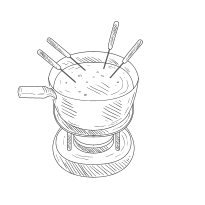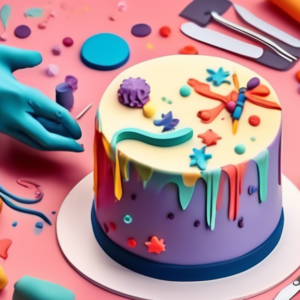How to Cover a Cake with Fondant Like a Pro
What is Fondant?
Fondant is a magical paste made from sugar, water, and glucose, that transforms ordinary cakes into stunning masterpieces. It’s like edible Play-Doh for bakers, allowing you to create smooth, flawless finishes and intricate decorations that will wow your friends and family.
Types of Fondant:
Before we dive into the how-to, let’s talk about the different types of fondant:
1. Rolled Fondant:
This is the most common type of fondant, perfect for covering cakes and making decorations. It’s readily available in cake supply stores and comes in a rainbow of pre-colored options or in a plain white canvas, ready for your artistic touch.
2. Poured Fondant:
As the name suggests, this type of fondant is poured over cakes and pastries, creating a smooth, glossy finish. It’s typically used for smaller treats like petit fours and cookies.
3. Sculpted Fondant:
This is the superhero of fondants, used to create elaborate 3D decorations, figurines, and show-stopping cake toppers. It’s a bit firmer than rolled fondant, allowing it to hold its shape like a champ.
Gathering Your Fondant Tools:
Now that you know your fondant types, let’s gather the essential tools to embark on your fondant adventure:
1. Fondant Smoothers:
These are your trusty sidekicks in achieving a flawless finish. Look for a variety of shapes and sizes to smooth out every nook and cranny.
2. Rolling Pin:
A large, non-stick rolling pin is your go-to for evenly rolling out the fondant to the perfect thickness.
3. Pizza Cutter or Sharp Knife:
These will be your best friends for trimming excess fondant and creating clean, precise edges.
4. Fondant Cutters:
Unleash your inner artist with a variety of fondant cutters to create shapes, letters, and intricate designs.
5. Cornstarch or Powdered Sugar:
These are your anti-stick secret weapons, preventing the fondant from sticking to your work surface and rolling pin.
Preparing Your Cake for Fondant:
Before you drape your cake in its fondant finery, you need to create a smooth and stable base. Here’s how:
1. Level and Tort:
If your cake has any domed tops, carefully slice them off to create a level surface. You can also tort your cake by slicing it into layers, which allows for more filling and stability.
2. Crumb Coat:
Apply a thin layer of buttercream frosting to your cake, sealing in any stray crumbs and creating a smooth canvas for the fondant. Chill the cake for about 30 minutes to allow the crumb coat to firm up.
Step-by-Step Guide to Covering a Cake with Fondant:
Now, the moment you’ve been waiting for – let’s cover that cake!
1. Kneading and Coloring:
If you’re using pre-colored fondant, give it a quick knead to warm it up and make it more pliable. If you’re starting with white fondant, now’s the time to add your desired food coloring. Remember, a little goes a long way!
2. Rolling Out the Fondant:
Lightly dust your work surface with cornstarch or powdered sugar to prevent sticking. Roll out your fondant to about ¼ inch thickness, rotating it frequently to ensure evenness.
3. Draping the Fondant:
Carefully lift the rolled-out fondant over your rolling pin and gently drape it over the cake. Make sure the fondant covers the entire cake with some excess around the sides.
4. Smoothing the Top and Sides:
Use your fondant smoothers to gently smooth out any air bubbles and wrinkles, starting from the top and working your way down the sides.
5. Trimming the Excess:
Use a sharp knife or pizza cutter to trim off the excess fondant at the base of the cake, creating a clean and polished look.
Fondant Decoration Ideas:
Now that your cake is beautifully covered in fondant, let’s add some personality and flair!
1. Fondant Cutouts:
Use fondant cutters to create shapes, letters, or numbers. Attach them to your cake with a dab of water or edible glue.
2. Fondant Molding:
Press fondant into silicone molds to create intricate designs, textures, and even edible lace.
3. Edible Painting:
Unleash your inner artist by painting on fondant with edible food colors. You can create stunning designs, personalized messages, or even replicate famous works of art!
4. Edible Details:
Add edible pearls, sprinkles, or dragees for a touch of sparkle and texture. You can also create fondant bows, flowers, or other decorative elements.
Tips for Fondant Success:
Here are some expert tips to ensure your fondant adventure is a sweet success:
1. Keep it Cool:
Fondant melts in high humidity, so it’s best to work in a cool, dry environment.
2. Don’t Overwork It:
Overkneading fondant can make it tough and difficult to work with. Knead it just until smooth and pliable.
3. Embrace the Imperfections:
Fondant can be a bit finicky, but don’t let small imperfections discourage you. Embrace the handmade charm, and remember, it’s all about having fun!
Conclusion
Covering a cake with fondant is a rewarding and impressive baking skill. With a bit of practice and patience, you’ll be creating stunning fondant masterpieces in no time. Embrace your creativity, have fun, and enjoy the sweet rewards of your efforts!

